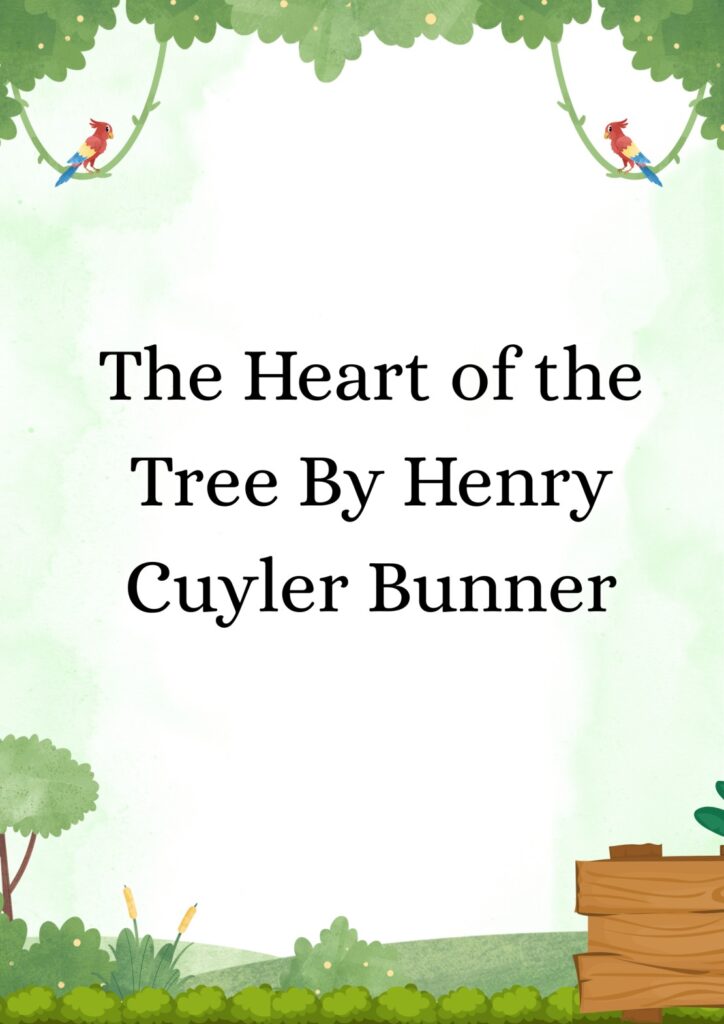Discover the inspiring summary of The Heart of the Tree by Henry Cuyler Bunner, a poem that highlights the environmental, social, and spiritual value of planting trees.
The Heart of the Tree Line by Line Summary By Henry Cuyler Bunner

BUY AUTHOR’S FAMOUS BOOK ON AMAZON
Summary of The Heart of the Tree By Henry Cuyler Bunner
Poet Introduction – Henry Cuyler Bunner
Henry Cuyler Bunner (1855–1896) was a famous American poet, writer and journalist. He is known for writing on topics related to social issues and human values. His poem “The Heart of the Tree” reflects his love for the environment and concern for future generations. This poem is short, but its meaning is very deep and inspiring.
Theme & Message of the Poem
This poem presents a seemingly simple task — “planting trees” — as a great social, moral and national duty. The poet tells us that planting trees is not just a biological process, but a quiet but powerful contribution made by a person to the earth, nature, society and nation.
Structure of the Poem
The poem is divided into three stanzas. Each stanza begins with the same question:
“What does he plant who plants a tree?”
This question is the center of the poet’s thoughts, and the entire emotion of the poem is contained in its answer.
Meaning of the first stanza: Establishment of the beauty and peace of nature
In the first stanza, the poet tells what the person who plants a tree is actually doing. He is not just planting a tree, but:
He is laying the foundation of a cool shade, a cool breeze, and an environment full of greenery.
He is building a home for the birds who will nest on the branches, sing songs and create the music of nature.
That tree will stand as a beautiful sight in the future, which will fill the mind of the onlookers with joy.
✨ This tree will enhance the beauty of the earth and make it life-giving.
The poet here considers the tree not just an object, but a sensitive and living structure, which serves humans and other living beings.
Meaning of the second stanza: Education, culture and responsibility towards the future
The second stanza makes the poem more profound. In it, the poet says that the person who plants a tree:
Is leaving a legacy for future generations – a gift that will give shade, fruits and freshness for years.
He is making cities and villages beautiful, where people will sit, talk, read or play under that tree.
That tree will one day stand in the courtyard of a school, where children will receive education in its shade.
This tree will become an economic and cultural asset for the future – wood, fruits, flowers, air and beauty will all be contained in it.
Thus, planting trees is not just a duty for the present, but a duty to build the future.
This stanza teaches that a responsible citizen is one who, by his actions today, ensures the well-being of the society tomorrow.
Meaning of the third stanza: Form of national service and patriotism
In the third and final stanza, the poet connects tree planting with the feeling of patriotism. He says that:
The person who plants a tree lays the foundation of the nation’s future.
The tree not only provides natural resources, but it also enriches the lives of the citizens of the country.
This tree becomes the source of the wind singing in the air, the sun’s rays spreading far and wide and the greenery of the earth.
In this way, the roots of the tree go to the heart of the nation – and its branches spread to the sky.
This idea is very impressive – that one who silently sows a seed is building the nation without any noise.
Symbolic Interpretation of the Poem
Symbolic Meaning
Tree Planting Selfless service, environmental protection, responsibility towards society and nation
Birds Freedom, music, simplicity of life
Branches Diversity and expansion of society
Roots Values, tradition and stability
Sunrays Hope, progress and light of the future
Depth of the poem and philosophical message
There is a great philosophy hidden in the poem – that planting trees is an act which:
Without saying anything, makes a person big, true and useful.
This act is for those who know how to live for others.
Planting trees is not just filling soil in a hole, but it is sowing faith, hope and love.
The poet makes it clear that the person who plants a tree:
Makes the earth created by God more beautiful.
Gives wings to natural music.
And contributes to the society without seeking praise.
Moral & Life Lessons
Connecting with nature is the root of humanity.
What we sow today, bears fruit tomorrow — so sow wisely.
Social work is not done only by speeches, but by small actions.
It is the responsibility of every citizen to leave a better world for the coming generations.
Patriotism is not only done by hoisting the flag, but also by protecting nature.
❤️ The beauty of the poem from an emotional point of view
The biggest strength of this poem is its emotional power. It touches the heart of the reader and inspires him to plant trees too — not only for himself, but for his children, country and earth.
When you read this line of the poem:
“He plants a tree who plants a hope”
you realize that these are not just words — it is a call, an inspiration.
Conclusion
Henry Cuyler Bunner’s poem “The Heart of the Tree” teaches us that planting a tree is not just an action, but a duty, a prayer, and the foundation of a future.
This poem becomes even more relevant in today’s times, when the environmental crisis is deepening. The poet reminds us that planting trees means giving life, sowing peace, and securing the future of civilization.